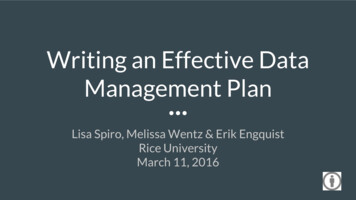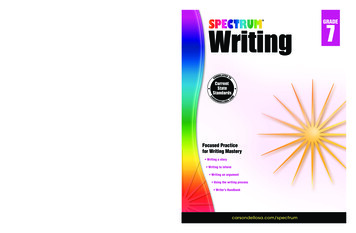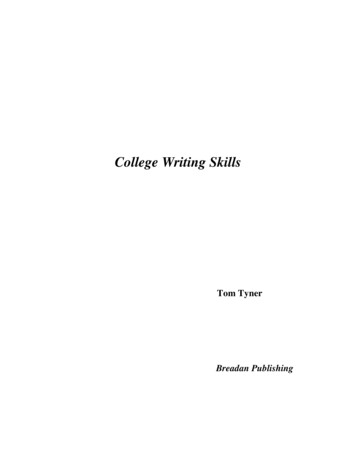
Transcription
Writing an Effective DataManagement PlanLisa Spiro, Melissa Wentz & Erik EngquistRice UniversityMarch 11, 2016
Outline1. Discuss challenges in developing data managementplans (DMPs)2. Review examples of agency guidelines3. Highlight best practices for data management4. Evaluate a sample plan5. Experiment with DMP Tool6. Explore resources for writing DMPs
1. What challenges doyou face in dealingwith data?
2. Examples of agency guidelines
Nearly All Federal Funding Agencies (& SomeNonprofits) Require or Will Soon Require DMPs NSF (specific guidelinesby directorate) NIH CDC NEH Office of DigitalHumanities DOE DOTFDANOAAUSAIDUSGSMoore FoundationAlfred P. SloanFoundation .
Why do funding agencies require DMPs? Facilitate replication of resultsAllow alternative hypotheses to be testedEnable comparative studiesPromote new researchFoster educationMaximize investment of research money
Data: “the recorded factual material commonly accepted inthe scientific community as necessary to validate researchfindings” Values openness for fostering scientific progress & integrity. Respects norms of disciplinary communities. Recognizes constraints such as confidentiality & intellectualproperty. Promotes “timely access” while respecting rights ofresearchers to analyze data & publish results.
PI is the primary steward of data & is responsible for: Educating research team on “obligations regardingresearch data” Ensuring accuracy, security & management of data Complying with sponsor requirements Researcher has right to choose research directions, publishwork & share findings. Rice holds legal title to data. Normal retention period for data 5 years after grantexpiration.
Information to Include in NSF DMPsGuidelines vary by directorate, but generally require: Types of dataStandards to be used for data & metadataPolicies for access and sharing (including IP)Policies and provisions for re-use & re-distributionPlans for archiving data and for preserving access
Read the Guidelines. Pay attention to the specific requirements of yourfunding agency. Typically DMPs are 2 pages long.
DMPs and Compliance Proposals without DMPs will not be reviewed. Some agencies/directorates (e.g. NSF Bio) requirereporting on DMP implementation in annual & finalreports. Some directorates will consider DMPimplementation in evaluating future proposals. Pay attention to policies governing how datashould be handled, e.g. HIPAA.
3. Some Best Practices for ManagingResearch Data
1. Understand your data. What kind of data will you produce/ use? What computing resources are needed? What will be the workflow for managing data? How much data will you be generating? What costs will be associated with managing data?These can often be written into grants. Are there restrictions on the data (e.g. HIPAA)?
2. Draw upon data management norms for yourdiscipline. Ecology: British Ecological Society and ESA Environmental science: DataONE Social science: ICPSR, Dataverse & The AmericanEconomic Review: Data Availability Policy Know up front what is required to share data through yourdiscipline’s repository (e.g. ICPSR).
3. Describe your data. Document your data, recording information like title,creator, dates, subject, context & methods. Use established metadata standards so data arediscoverable & interpretable. e.g. Ecological Metadata Language or DataDocumentation Initiative [DDI]
Example ofMetadata forData: DryadBased on DublinCore dryad.fc74k
4. Use effective storage strategies. Keep 3 copies of data in multiple locations: “original, nearand far” (e.g. hard drive, external drive, server) Manage versions of files (e.g. using Subversion or GitHub) Determine who needs access to files & ensure they aretrained in properly handling them. Provide appropriate security for data (e.g. anti-virusprotection, access control, encryption, de-identification ofdata). Store data in non-proprietary formats (e.g. .txt not .doc)
Storage Options atRiceCrate: “research storagesolution for Rice researchers;500GB per research award”Archive: “research solution forlong-term retention ofcompleted work”Box: “enterprise cloud-basedstorage & collaboration service”
5. Share data through an appropriate data archive.Agencies permit differentapproaches to data sharing.Perhaps the best is to use anational data archive.Why share?http://www.re3data.org/ Increase citations Meet reproducibility & datasharing standards Facilitate future research
Share Small to Medium Datasets through theRice Digital Scholarship 660
4. Evaluate a sample plan
How to Evaluate a DMPCenter for DigitalResearch &Scholarship,Columbia UniversityLibraries, “Reviewer’sWorksheet for NSFData ManagementPlans”
Exercise: Let’s evaluate a sample planUse the “Reviewers’ Worksheet” to evaluate either“Rio Grande Basin” or the workshop on AfroCaribbean Labor (NEH) [10 minutes]Consider: What are this plan’s strengths? Weaknesses? What is your overall evaluation?
5. Experiment with DMP Tool
Creating DMPs Using DMPToolhttps://dmptool.org
Exercise: Sketch out a DMP Log into https://dmptool.org Select the NSF-Earth Sciences template. Create a draft DMP for “Rio Grande.” Try to improve uponthe plan that you’ve been provided. Alternatively, you can create a DMP for your own (real orimagined) project using the appropriate template.
6. Data Management Resources atRice & Beyond
Help Provided by the Rice Research DataManagement Team Assistance developing data management plans. Consultation on organizing and managing data. Assistance identifying appropriate datarepositories. W: http://researchdata.rice.edu/ E: researchdata@rice.edu
Help Provided by the Office of ProposalDevelopment Assist in developing your proposal, including the DMPIdentify components that should be included in the DMPDraft the non-technical parts of the DMPReview, edit, and format the final version of the DMPConnect you with other data management resources oncampus and online Office of Proposal Development
DMP Components*NSF - program solicitation or NSF GPGNIH - FOA or Application GuideDOE - FOA or Statement of Digital Data Management*good idea to reference elements of research planAnother Resource: Office of Research Compliance
Help Provided by Rice’s Center for ResearchComputing “Operating best-in class on-premise shared compute,visualization and data-storage facilities; Facilitating access to on-premise, regional, nationaland commercial cloud facilities; Delivering user services and training for best use ofshared facilities; Offering application and proposal consulting supportservices.”
Helpful Resources Borer, Elizabeth T., et al “Some Simple Guidelines for Effective DataManagement.” Bulletin of the Ecological Society of America (2009): 205–14. doi:10.1890/0012-9623-90.2.205. Data Carpentry and Software Carpentry Data One, Primer on Data Management NISO Primer, Research Data Management U of Oregon Libraries, Research Data Management Best Practices UK Data Service Costing Tool UNC Research Data Toolkit: Example Language USGS Data Management
More Helpful ResourcesDataOne Primer on Data ManagementDataverse, Data Management PlansICPSR Guide to Social Science Data Preparation and ArchivingOak Ridge National Lab Distributed Active Archive Center, BestPractices for Preparing Environmental Data Sets to Share and Archive Svend Juul et al, “Take good care of your data” UK Data Archive, Managing and Sharing Data: Best Practices forResearchers White, Ethan P., et al “Nine Simple Ways to Make It Easier to (re)useYour Data.” Ideas in Ecology and Evolution (8/30/ 2013).
Use effective storage strategies. Keep 3 copies of data in multiple locations: "original, near . Connect you with other data management resources on campus and online Office of Proposal Development. . Data Carpentry and Software Carpentry Data One, Primer on Data Management NISO Primer, Research Data Management .











